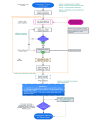Implementing Remote Radiotherapy Planning to Increase Patient Flow at a Johannesburg Academic Hospital, South Africa: Protocol for a Prospective Feasibility Study
- PMID: 40601425
- PMCID: PMC12340459
- DOI: 10.2196/60131
Implementing Remote Radiotherapy Planning to Increase Patient Flow at a Johannesburg Academic Hospital, South Africa: Protocol for a Prospective Feasibility Study
Abstract
Background: Access to timely radiotherapy in resource-constrained environments, particularly low- and middle-income countries (LMIC), is hampered by infrastructure constraints, workforce shortages, and a rising cancer burden. Remote radiotherapy planning (treatment planning as a service [TPaaS]) has the potential to enhance workflow efficiency, reduce wait times, and expand access to treatment. However, its integration and feasibility in LMIC public health systems remain underexplored.
Objective: This study evaluates the feasibility and initial effectiveness of remote radiotherapy planning using the Varian Eclipse system integrated with Elekta Versa HD linear accelerators (LINACs) at the busiest public hospital in South Africa. The primary goal is to determine whether remote planning can maintain plan quality while enhancing efficiency and minimizing treatment delays.
Methods: A prospective, single-site, pilot study is being conducted at Charlotte Maxeke Johannesburg Academic Hospital (CMJAH) in 2 phases. Phase 1 (feasibility) encompasses system commissioning, including beam modeling, computed tomography (CT)-to-electron density calibration, multileaf collimator (MLC) optimization, and dose calculations using the anisotropic analytical algorithm. System performance is validated through gamma index analysis (≥95% pass at 3%/3 mm). Interoperability and workflow readiness are assessed using simulated clinical scenarios and time integration steps. Phase 2 (effectiveness/impact) evaluates operational outcomes in 100 screened adult patients (≥18 years) with cervical, breast, prostate, head and neck, or rectal cancers requiring curative radiotherapy. Patients are grouped by cancer type (25 per group). Time to treatment, plan quality, and system efficiency will be compared with historical in-person planning data. Key workflow metrics include dates of first consultation, CT simulation, planning initiation, plan approval, quality assurance, and treatment start and completion.
Results: The study commenced enrollment in November 2023, with completion anticipated by mid-2025. As of July 2024, approximately 44 patients were screened and are anticipated to complete the remote planning. Initial findings show successful MLC transmission and dosimetric leaf gap optimization through iterative testing. Gamma pass rates exceeded 90% on both clinical and test servers, demonstrating initial accuracy. Results, including planning timelines, quality assurance outcomes, and system performance, will be available following comprehensive analysis in the third quarter of 2025. Preliminary findings indicate effective integration of remote planning in a resource-constrained public health sector setting.
Conclusions: This study shows that remote radiotherapy planning is feasible and might improve cancer treatment in LMIC. The integration of commercially available systems, such as TPaaS, was successfully achieved without compromising dosimetric quality and ensured workflow continuity. Remote planning could serve as an effective tool to reduce treatment delays and enhance resource utilization in oncology units facing high demand. These findings offer valuable insights into technical integration, quality planning, and workflow outcomes, which can inform the future implementation of effective strategies in resource-constrained settings.
International registered report identifier (irrid): DERR1-10.2196/60131.
Keywords: cancer care; feasibility; quality assurance; radiotherapy; remote radiotherapy; remote radiotherapy planning services; remote treatment; treatment planning.
©Duvern Ramiah, Sonwabile Ngcezu, Oluwatosin Ayeni, Okechinyere Achilonu, Mariam Adeleke, Theo Nair, Joseph Otten, Daniel Mmereki. Originally published in JMIR Research Protocols (https://www.researchprotocols.org), 28.07.2025.
Conflict of interest statement
Conflicts of Interest: None declared.
Figures



Similar articles
-
Comparison of Two Modern Survival Prediction Tools, SORG-MLA and METSSS, in Patients With Symptomatic Long-bone Metastases Who Underwent Local Treatment With Surgery Followed by Radiotherapy and With Radiotherapy Alone.Clin Orthop Relat Res. 2024 Dec 1;482(12):2193-2208. doi: 10.1097/CORR.0000000000003185. Epub 2024 Jul 23. Clin Orthop Relat Res. 2024. PMID: 39051924
-
A rapid and systematic review of the clinical effectiveness and cost-effectiveness of paclitaxel, docetaxel, gemcitabine and vinorelbine in non-small-cell lung cancer.Health Technol Assess. 2001;5(32):1-195. doi: 10.3310/hta5320. Health Technol Assess. 2001. PMID: 12065068
-
Evaluation of the efficacy of automated machine learning enhanced planning system and a comparative analysis with manual planning system.J Cancer Res Ther. 2025 Apr 1;21(3):593-601. doi: 10.4103/jcrt.jcrt_1373_24. Epub 2025 Jul 5. J Cancer Res Ther. 2025. PMID: 40616541
-
Home treatment for mental health problems: a systematic review.Health Technol Assess. 2001;5(15):1-139. doi: 10.3310/hta5150. Health Technol Assess. 2001. PMID: 11532236
-
[Volume and health outcomes: evidence from systematic reviews and from evaluation of Italian hospital data].Epidemiol Prev. 2013 Mar-Jun;37(2-3 Suppl 2):1-100. Epidemiol Prev. 2013. PMID: 23851286 Italian.
References
-
- Kirkpatrick S, Davey Z, Wright PR, Henshall C. Supportive eHealth technologies and their effects on physical functioning and quality of life for people with lung cancer: systematic review. J Med Internet Res. 2024 Jul 26;26:e53015. doi: 10.2196/53015. https://www.jmir.org/2024//e53015/ v26i1e53015 - DOI - PMC - PubMed
-
- Sung H, Ferlay J, Siegel RL, Laversanne M, Soerjomataram I, Jemal A, Bray F. Global Cancer Statistics 2020: GLOBOCAN estimates of incidence and mortality worldwide for 36 cancers in 185 countries. CA Cancer J Clin. 2021 May;71(3):209–249. doi: 10.3322/caac.21660. https://onlinelibrary.wiley.com/doi/10.3322/caac.21660 - DOI - DOI - PubMed
-
- Yang HC, Chung SH, Yoo JS, Park B, Kim MS, Lee JM. Evaluation of a smart after-care program for patients with lung cancer: a prospective, single-arm pilot study. J Chest Surg. 2022 Apr 05;55(2):108–117. doi: 10.5090/jcs.21.138. https://europepmc.org/abstract/MED/35135903 jcs.21.138 - DOI - PMC - PubMed
-
- Zhang L, Jiang S. Examining the role of information behavior in linking cancer risk perception and cancer worry to cancer fatalism in China: cross-sectional survey study. J Med Internet Res. 2024 May 31;26:e49383. doi: 10.2196/49383. https://www.jmir.org/2024//e49383/ v26i1e49383 - DOI - PMC - PubMed
MeSH terms
LinkOut - more resources
Full Text Sources
Medical
Research Materials
Miscellaneous

